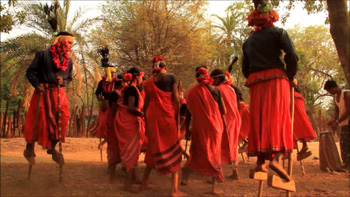Muria Dance
Muria Dance |
About: |
|
The Murias are the people who belong to the Muria Tribe and reside in the Northern part of Bastar district. The Murias are trained and taught several community dances in the Ghotul. As per the culture and tradition of this clan, the Murias first worship their drum before performing the dance. They basically dance and sing during some occasion and festivals. A colourful picture of the performing arts of Madhya Pradesh can be observed during marriages in the household of the clan. Before performing any dance or song the Murias pray to the 'Lingo Pen', who is the founder of the Ghotul institution and is regarded as the phallic deity of the tribe. Their neighbours, the Murias, are known for their tradition drum dances called Mandri. It is mainly the dance of boys, who play the drum along with dancing. Sometimes girls also join them, though they appear grouped separately. The dance movements and steps of the boys are often complicated, involving kneeling, jumping, gyrating and the like, but at no time is there a let-up in the playing of the drum. Muria tribal man with the wooden drum called Kaumut The Muria tribals of North Bastar area are known for performing the fold dances of Muria. These dances start with an invocation or prayer to the phallic deity of their tribe and the founder of the Ghotul institution. One of the popular Muria dances comprises of Har Endanna dance, performed by boys and girls during marriages. Then, there is the Karsana dance, performed for fun and enjoyment. As for the Hulki dance, it is the most beautiful of all Muria dances and has boys moving in a circular fashion, while the girls make their way through them. There are many dances of the Muria Tribe that are a treat to eyes. The folks of the tribe get the basic training for these dances during Ghotul (a dormitory where teenage boys and girls mingle to gain knowledge and social ethics) itself. The main dances of the tribe are Har Endanna and Hulki. Har Endanna dance is performed during the marriage ceremonies. The dance has both boy and girl performers. Noteworthy thing of the dance is the movements of the drummers and the subtle changes they give to the drumming. It would surprise many to learn that there are certain tribal customs in our country which would seem scandalous, by modern standards. One such tribe is the Muria, who are the inhabitants of North Bastar. They have a custom called Ghotul. The Ghotul is a kind of dormitory where unmarried men and women freely establish sexual relations. This is sanctioned by the tribe and is an integral part of Muria society. The dancing site is chosen near the Ghotul compound. On marriage celebrations, the Muria boys and girls perform a dance called Har Endanna. The dance commences with a group of boys carrying ritualistic offerings and gifts and conducting the bridegroom to the ceremonial place. In this light and happy dance, there are a variety of movements with the boy and the girl dancers and drummers participating to move in patterns with running steps and circles then changing directions, kneeling, bending and jumping. The movements of the drummers as they dance and manipulate their drums is fascinating. The Muria dance, Madhya Pradesh is a famous folk dance of Madhya Pradesh and is performed near the Ghotul compound. The dance starts with the boys carrying ritualistic offerings along with the bridegroom to the ceremonial place. The Muria dances are of many types. In this dance, there are a variety of movements. The boys and the girls participate enthusiastically. The dance has a fixed moving pattern with running steps and circles. The performers kneel down, bend and jump as a part of the movement in the Muria Dance, Madhya Pradesh. During the performance of Muria Dance in Madhya Pradesh in India, the drummers also move along with the dancers and keep on manipulating the rhythm. There are a variety of Muria dance, like, the Hulki, the Har Endanna, the Karsana etc. The dances are performed for fun and enjoyment. The dance steps are quick and vibrant which adds an element of rhythm to the whole form. Performing Arts of Madhya Pradesh has been an important part of the tradition and culture. Most of the dances and songs and other arts practised in Madhya Pradesh are tribal in nature because of the majority in the tribal population residing in the state. Tourists travelling to Madhya Pradesh can experience this vibrant dance and song culture of the state by going to a fair or during the time of festivals. There is an intriguing legend behind the origin of the custom. It is said that Lingo Pen is a Phallic deity and founder of the Muria Ghotul. Legend has it that Lingo Pen was a proficient musician. He first taught the art of drumming to tribal boys. Amongst the Murias, a good drummer is regarded as a good lover. A Muria proverb says: "One who can beat a drum knows how to beat a girl in love." In the mythological accounts of the Murias, Lingo Pen is all-powerful. No witch or ghost can invade the atmosphere of the Ghotul because of his invisible presence. Since Lingo is also the God of love, sin has no place within the Ghotul’s boundary. Muria society seems to be a highly evolved. It has found and implemented a unique system which circumvents the dangerous ramifications of love relationships. Romantic liaisons cause many a crime and the Murias have successfully avoided it within their tribe. |

.jpg)
.jpg)
.jpg)
.jpg)